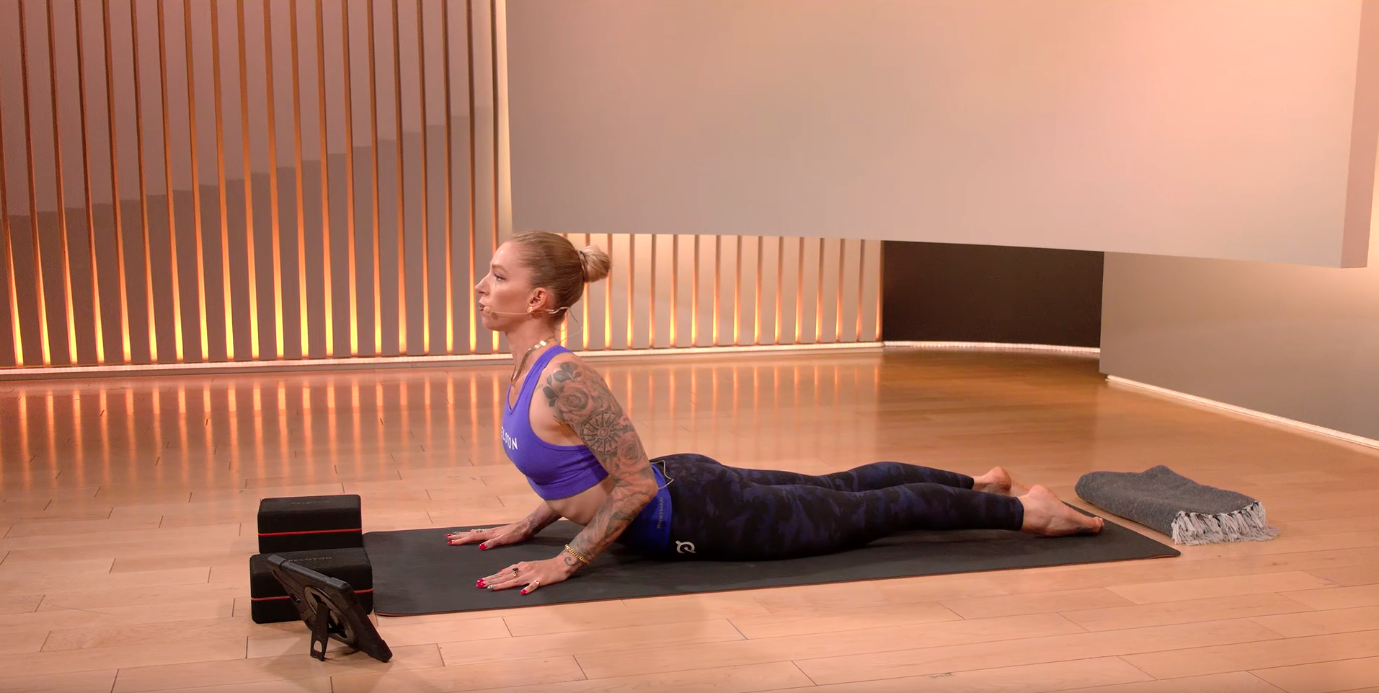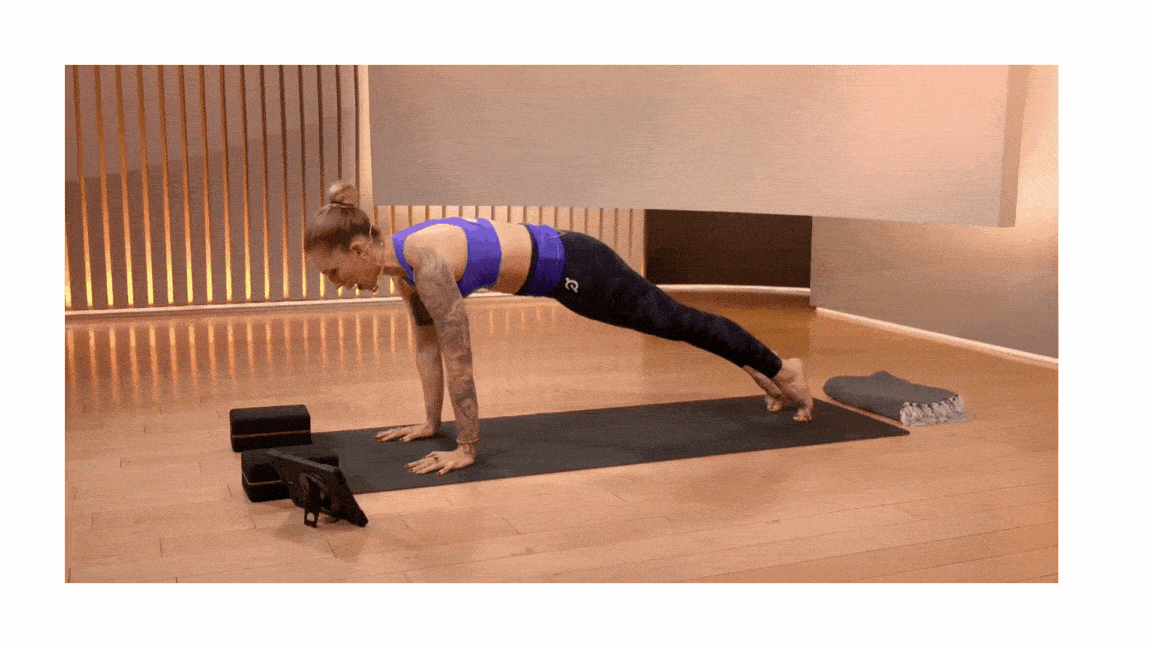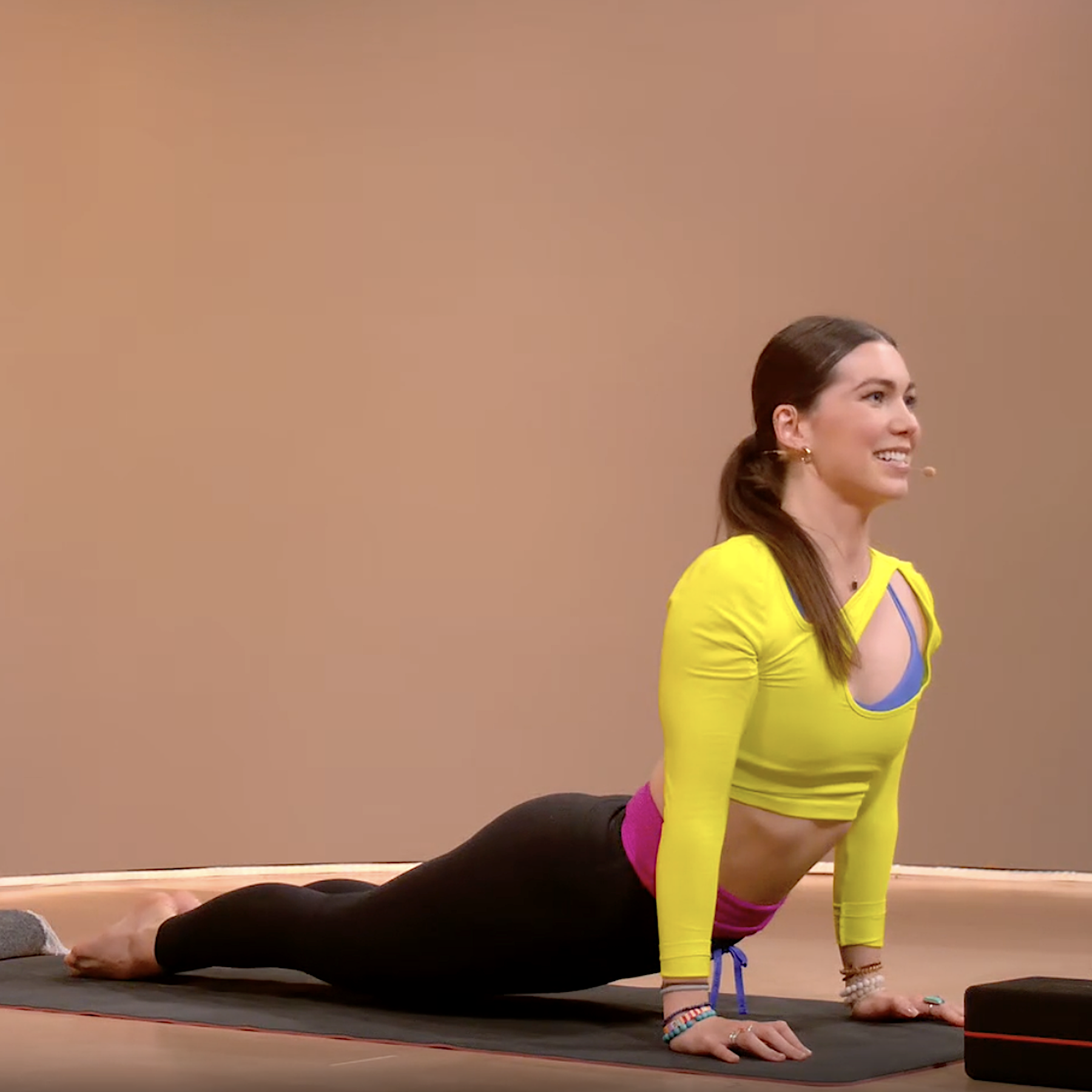
Want to Practice Cobra Pose? Let Peloton Instructor Kirra Michel Show You How
Discover how to maximize the benefits of this heart-opener.
By Karla Walsh•
What is Cobra Pose?
How to Do Cobra Pose
The Benefits of Cobra Pose
Cobra Pose vs. Upward Dog
What About Baby Cobra Pose?
The Bottom Line
The moments you spend in cobra yoga pose as part of a sun salutation might feel like a mindless step on the way to a position that’s more impactful. However, cobra pose is a worthy and impactful step in the flow—and is much more than a transition.
To help you safely and effectively ace this posture, we tapped Peloton instructor Kirra Michel to walk us through how-to do cobra pose, her top cobra tips, plus how cobra differs from its cousins baby cobra and upward dog.
What is Cobra Pose?
Cobra pose, which you may have heard by its Sanskrit name of Bhujaṅgāsana (boo-jang-gahs-anna), falls into the backbend, back extension, or heart-opener family of yoga postures.
“Cobra is a milder backbend than most others and is a great modification and starting off point for many practitioners,” Kirra explains. “It frequently shows up in Vinyasa yoga sequences, power yoga, and in yoga warm-ups. Cobra is a strong base and foundation for backbends, allowing the practitioner to elongate and extend the spine and open up the front body.”
In case you missed it, Vinyasa is one of the most popular types of yoga. It tends to be faster-paced and more active than many other styles, and involves stringing together poses in a fluid, continuous, breath-synchronized sequence.
Sun salutation is one of the common series during which you’ll experience cobra pose; Peloton App users can check out this 10-Minute Yoga Flow, which features sun salutation. Cobra is the step between core-strengthening plank and hamstring-stretching downward dog.
There are three styles of sun salutation—A, B and C—and cobra is integrated into sun salutation C. Sun salutations A and B feature upward-facing dog instead— more about the differences between cobra and upward-facing dog ahead.
During cobra, you’re working:
Spinal extensors and serratus posterior, which extend the spine and allow you to stand up and lift.
Serratus anterior, which stabilizes the shoulder blades, and helps your arms push your upper body away from the mat.
Rotator cuffs, which stabilize the shoulder joint.
Psoas, abdominals and hamstrings
Triceps extend and support the arms as they press into the mat
How to Do Cobra Pose
In addition to doing cobra pose as part of a flow, you can also perform it as a stand-alone pose. It’s a great way to stretch and open up the chest, shoulders, and back after a long day of desk time, an extended flight or commute, or any day that involves more tech time than usual.

How to do a cobra pose, according to Kirra:
Begin by lying face-down on a mat. Place your hands on the ground, fingertips just outside of your shoulders and in line with the front of your shoulder bones. Keep elbows parallel, at your sides and pulling straight back.
As you inhale, squeeze your shoulder blades together and, pressing into the mat through your hands, lift your chest off the ground. Reach your heart forward as you engage through your core, allowing for a mild backbend.
Draw your shoulders away from your ears by gliding them down until you feel steady and grounded.
Keep your legs long and firm behind you, as you press the tops of your feet into the ground.
Hold for 3 to 5 long, slow breaths.
Exhale to gently lower down and rest your chest and forehead on the mat.
As you try cobra pose , keep these pro tips in mind:
Imagine your shoulder blades almost touching. “Make sure to draw your shoulder blades together behind you,” Kirra advises.
Don’t “wear” your shoulders as earrings. As you soften shoulders away from your ears, you’ll be able to allow your chest to fully open.
Aim for a long back. “Think about lengthening your spine from the crown of your head to your tailbone, rather than trying to force yourself into a deep backbend,” Kirra says.
Space out your weight. Try to evenly-distribute the weight of your body in your backbend, “rather than dumping it into the low back,” Kirra says. In other words, engage your muscles rather than relying on the flexibility of that region alone.
Mind your feet. If you feel any pressure in the low back, try spreading your feet further apart to lessen the pressure.
Gaze wisely. Be gentle with your neck. Look straight ahead or slightly down, whichever feels better, in order not to strain your next muscles.
Don’t push it. Each day will likely feel different. “Tailor the depth of the backbend that works best for you that day,” Kirra suggests. “No straining!"
The Benefits of Cobra Pose
You’ll score some serious body benefits from performing cobra pose, either alone or as part of a warm-up or flow.
According to Kirra, cobra pose:
Strengthens the spine and many muscles in the back of the body including spinal extensors, gluteus maximus, and hamstrings.
Stretches the front body including chest, abdominis, and psoas muscles.
Balances out and opens up the hunch many of us end up having as our go-to posture.
Opens the heart and the lungs.
Improves spinal flexibility and mobility.
Cobra Pose vs. Upward Dog
It’s easy to confuse cobra pose and upward-facing dog, since they look a bit similar. That being said, if you’d like to be sure to nail cobra pose, it differs because the front of your pelvis, knees, thighs, and hands are all on the ground. Your hands will be slightly in front of your chest, typically with a bend at the elbows. The depth of your backbend will be milder in cobra compared to an upward-facing dog.

In upward-facing dog, the tops of your feet and your hands are all that touch the ground. Your hands will typically be directly under your shoulders with your arms straight or just ever-so-slightly bent at the elbows. This placement helps with the load-bearing and structure of the pose, Kirra explains. In “up dog,” as it’s sometimes referred to, you’ll express a deeper backbend.
“Because upward-facing dog is a deeper backbend than cobra, it's more challenging for some people. It also requires load bearing on the wrists. If you notice any pain in upward-facing dog, or if you don’t feel sufficiently warmed up for a deeper backbend, modify it with cobra,” recommends Kirra.
In cobra, there are many different levels of spinal extension—from mild to slightly more intense—making this pose more attainable and safer for most yogis. You can always alternate between cobra and upward-facing dog interchangeably depending on how you’re feeling that day.
What About Baby Cobra Pose?
For an even calmer extension, with less pressure on your hands and wrists, and smaller backbend, consider baby cobra.
“While in baby cobra, place light—or even no weight—in your hands. Your bent arms will result in a mild backbend. In cobra pose, the hands will hold more weight, with elbows less bent and arms straighter, allowing for a deeper backbend. How bent or extended the arms are determine the depth of your backbend,” Kirra says.
The Bottom Line
Cobra pose is one of the most common yoga poses in the category of heart-openers or back extensions. Compared to other backbends, cobra is among the most mild, making it an excellent option for yoga beginners, anyone with limited mobility, or for a light opener at the end (or start) of a long day.
Level up your inbox.
Subscribe for a weekly dose of fitness, plus the latest promos, launches, and events.